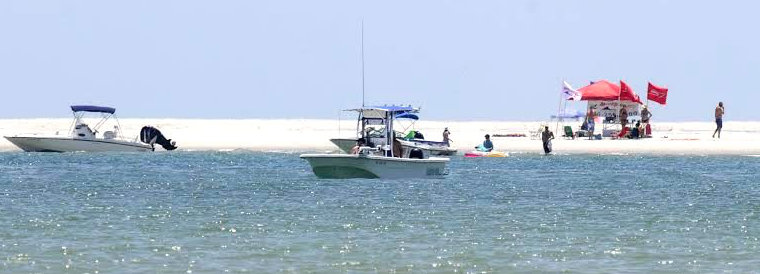
Latest update: In November 2017, Figure Eight Island homeowners rejected funding a proposed terminal groin at the north end of the island near Rich Inlet, adding another roadblock to the Figure Eight Island Homeowners’ Association plan for a terminal groin. This proposed terminal groin was already in jeopardy, as several homeowners stated they would not grant easements for the structure to be built on their properties.
Background
The Issue
Rich Inlet is one of the last naturally functioning inlets in North Carolina, and it serves as a place of recreation for many and as habitat for various shorebirds, sea turtles, fish and dolphins. But in 2011, the North Carolina General Assembly passed a law that allowed five terminal groins to be built along the North Carolina coast. The Figure Eight Island Homeowners’ Association applied for a permit shortly after the law passed, and the inlet and surrounding beach were put at risk.
Federation staff launched the Save Rich Inlet campaign in 2011 to educate residents about why a terminal groin — which would cost taxpayers an initial $7.3 million for construction and $23.5 million to upwards of $50 million over a 30-year period for maintenance and beach fill — was unnecessary for the area. The proposed site for the terminal groin has been accreting sand in recent years. Furthermore, terminal groins can cause unintended erosion down the beach from its location.
In addition to the habitat and access the terminal groin would affect — as well as the high cost of the project — several property owners do not want the terminal groin to be built on their property. The federation, through the SELC in 2016, contended that the Army Corps of Engineers and the HOA could not move forward with the project. More than a dozen homeowners said they would not grant easements for the terminal groin construction, and as a result, the Corps of Engineers should not have granted the HOA a permit. The HOA cannot apply for a state Coastal Area Management Act permit without the easements.
Shortly after the federation submitted its letter, the results came in from the special assessment vote. Federation staff members are monitoring the situation and waiting to see if the HOA will withdraw its application.
What’s At Stake
Damage & erosion: A terminal groin may result in damage and erosion on adjacent islands and estuaries further down-drift from the groin. Rich Inlet is one of the most stable inlets in the state and has remained in the same general location for the past 100 years.
Critical habitat: The proposed hardened structure along this natural beach and inlet system threatens to destroy critical habitat for fish, birds and sea turtles.
Public access & recreation: A terminal groin at Rich Inlet would eliminate treasured public beach areas used by thousands of people every year for fishing, boating and swimming.
Updates
Comment letters & fact sheets from the campaign:
- Rich Inlet Fact Sheet
- Read the comment letter requesting that the Army Corps of Engineers return the permit application submitted by the Figure Eight Homeowners Association (September 2016).
- Read the comment letter on the final EIS from the federation (August 2016).
- Read the comment letter on the final EIS from the Southern Environmental Law Center (August 2016).
- Read the comment letter on the final EIS from Audubon North Carolina (August 2016).
- Read the comment letter on the final EIS from the Office of Environmental Compliance and Policy in the U.S. Department of Interior (August 2016).
- Read the comment letter on the final EIS from the U.S. Fish and Wildlife Service (July 2016).
- Read the comment letter on the supplemental EIS from the Southern Environmental Law Center (September 2015).
- Read the comment letter on the supplemental environmental impact statement (EIS) from the North Carolina Coastal Federation (September 2015).
- Read the comment letter on the supplemental EIS from Audubon North Carolina (September 2015).
Resources
- Documents from the Army Corps of Engineers, including the final EIS, comments on the final EIS and draft EIS and public notices.
For more background information, check out these articles:
- Work continues on Rich Inlet biological study
- Figure Eight Island homeowners reject proposed terminal groin
- Figure Eight Island terminal groin application is incomplete, inaccurate
- Federation submits comments on proposed Rich Inlet terminal groin
- Public comment period open for proposed Figure Eight Island terminal groin
- Migratory birds use North Carolina inlets as rest stops
- Save Rich Inlet public forum, Saturday, March 5
- Hearing set on Figure Eight terminal groin study
- Groin study is badly flawed
FAQ
What exactly is a terminal groin?
A terminal groin is a rock, concrete, stone or metal structure built on the side of an inlet at the end (terminus) of an island, perpendicular to the coast.
How does a groin work?
Groins trap some sand by blocking the current as it moves along the beach. Once about two or three hundred yards of sand is trapped, sand can move around the groin depending on the groin length, size and inlet geology. Groins do not prevent sand from entering inlets and channels, and are not designed to help with navigation.
Are groins and jetties the same?
No. Jetties are longer than groins and they are built for navigation purposes. Groins are built to try to keep a barrier island in place and to try to prevent erosion of beaches.
Will a terminal groin protect the island from hurricanes?
No. Groins are not meant to protect the island or the structures on it from hurricanes. In fact, they are as susceptible to hurricanes as any other structure on the island. They could cause unpredictable erosion damage because they can channel floodwaters in unnatural ways.

